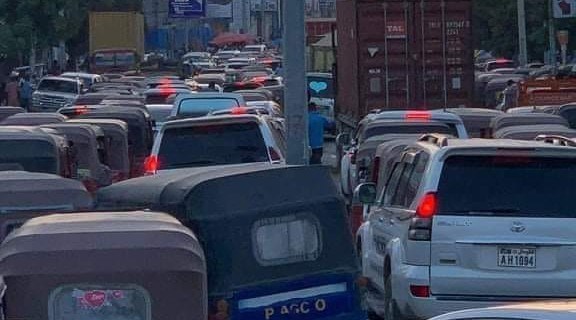By Mohamed Moalim (Wayaki)
Saturday August 16, 2025

In most cities around the world, traffic jams are a frustrating but orderly affair—lanes are (mostly) respected, signals are (usually) obeyed, and drivers yield to emergency vehicles. But in Mogadishu, Somalia’s bustling capital, traffic operates under an entirely different set of rules—or rather, a near-total absence of them.
A Road System That Exists—But Only in Theory
Mogadishu does have roads, somewhat painted lanes, and nonexistent traffic signals. But these are mere suggestions rather than enforced regulations. Drivers navigate the streets with a mix of aggression, instinct, and sheer audacity, treating traffic laws as optional guidelines rather than mandatory rules.
Unlike in other cities, where traffic flows in predictable patterns, Mogadishu’s roads are a free-for-all. A driver must be prepared for vehicles—whether armored 4x4s, rickshaws, motorcycles, or pedestrians—to appear from any direction at any time. There is no concept of right-of-way; instead, every inch of pavement is contested territory.
The Art of Improvised Lanes
In most places, a two-lane road means two lanes of traffic moving in opposite directions. In Mogadishu, it could mean three, four, or even five lanes as drivers squeeze into any available space. It’s not uncommon to see a motorcycle weaving between cars, a rickshaw cutting diagonally across traffic, or a pedestrian casually strolling through moving vehicles as if they were part of the road.
When congestion hits, drivers don’t wait patiently—they improvise. A small gap in oncoming traffic might suddenly become a new lane, forcing opposing vehicles to swerve or halt. The result? Gridlock that spreads unpredictably, with no clear way out.
Survival of the Boldest
Mogadishu’s traffic operates on a simple principle: move first, ask questions later. Hesitation is a luxury no driver can afford. Even emergency vehicles—ambulances, police cars, and security convoys—must fight their way through, sirens blaring, with no guarantee that anyone will yield.
In these chaotic, unruly roads, the biggest and boldest vehicles often prevail. Armored vehicles, p and SUVs push their way forward, while motorcycles dart through impossibly narrow gaps. Pedestrians, meanwhile, navigate the chaos with a mix of patience and fearless determination.
A City That Moves—Somehow
Despite the apparent anarchy, Mogadishu’s traffic somehow keeps flowing. Drivers have developed an unspoken understanding, a sixth sense for anticipating each other’s moves. There are near-misses, honking matches, and occasional shouting, but accidents are surprisingly rare given the disorder.
For outsiders, Mogadishu’s roads are a nerve-wracking spectacle. For locals, it’s just another day—a testament to resilience, adaptability, and the unyielding will to keep moving, no matter the obstacles.
Chaos with Its Own Logic
Mogadishu’s traffic may seem lawless, but it follows its own unwritten rules—a high-stakes dance where only the most assertive survive. Yet beneath this chaos lies a deeper story. Decades of civil war, political collapse, and generational trauma have shaped the city’s psyche, leaving scars not only on its streets but also on its social fabric.
In a society where survival has often depended on quick decisions and aggressive assertion, patience and empathy have been eroded. The road becomes a mirror of this reality: a space where hesitation is punished, where the largest vehicle dominates, and where survival instincts override courtesy and consideration.
The absence of enforced law is not merely a traffic issue but a reflection of a broader culture shaped by conflict—where institutions are weak, order is fragile, and individual survival takes precedence over collective safety. The lack of empathy seen on the road is not a personal failing, but a survival mechanism born of years of instability, distrust, and hardship.
For those who drive in Mogadishu, traffic is more than a commute—it is a continuation of the city’s struggle to exist amid disorder. It is a reminder that beneath the horns, shouts, and daring maneuvers lies a population conditioned by war and survival, navigating not just the roads, but life itself, in a constant battle between chaos and endurance.
Mohamed Moalim (Wayaki)
Senior Policy Advisor
momoalim79@gmail.com
X twitter handle @wayakii